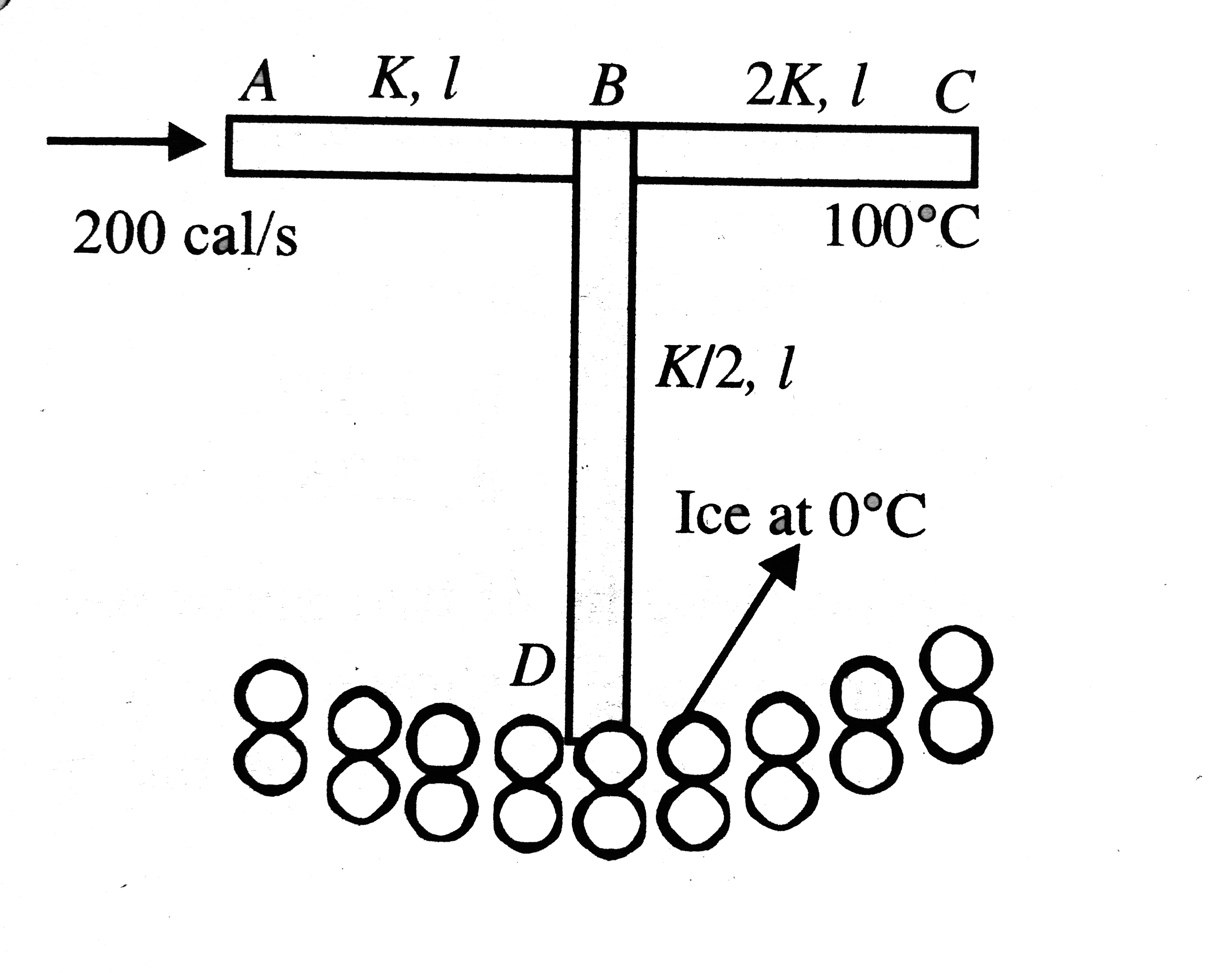If the depth of a lake is 10 m, and the temperature of surroundings is −10∘C and that of water at the bottom of the lake is 5∘C. The thermal conductivity of the Ice and water are Kf and Kw respectively. The depth of ice will be
5KwKw+Kl
10KwKw+2Kl
20KlKw+2Kl
None of these
The correct Answer is:C
To solve the problem of finding the depth of ice in the lake, we will use the principles of thermal conductivity and heat transfer. Here’s a step-by-step solution:
Step 1: Define the variables
- Let the depth of ice be x.
- The total depth of the lake is given as 10m.
- Therefore, the depth of water is 10−x.
- The temperature of the surroundings is −10∘C.
- The temperature of water at the bottom of the lake is 5∘C.
- The thermal conductivity of ice is Kf and that of water is Kw.
Step 2: Understand the heat transfer
In a steady state, the heat current through the ice layer must equal the heat current through the water layer. This can be expressed mathematically as:
Hice=Hwater
Step 3: Write the heat transfer equations
Using the formula for heat current (or heat transfer rate):
H=K⋅A⋅ΔTL
Where:
- H is the heat current,
- K is the thermal conductivity,
- A is the cross-sectional area,
- ΔT is the temperature difference,
- L is the thickness of the material.
For the ice:
Hice=Kf⋅A⋅(0−(−10))x=Kf⋅A⋅10x
For the water:
Hwater=Kw⋅A⋅(5−0)10−x=Kw⋅A⋅510−x
Step 4: Set the heat currents equal
Setting the two expressions equal gives:
Kf⋅A⋅10x=Kw⋅A⋅510−x
Since the area A cancels out, we can simplify this to:
Kf⋅10x=Kw⋅510−x
Step 5: Cross-multiply to solve for x
Cross-multiplying gives:
Kf⋅10⋅(10−x)=Kw⋅5⋅x
Expanding this:
10Kf⋅10−10Kf⋅x=5Kw⋅x
100Kf=10Kf⋅x+5Kw⋅x
100Kf=x(10Kf+5Kw)
Step 6: Solve for x
Rearranging gives:
x=100Kf10Kf+5Kw
Final Expression
Thus, the depth of ice x can be expressed as:
x=20KfKw+2Kf
- Let the depth of ice be x.
- The total depth of the lake is given as 10m.
- Therefore, the depth of water is 10−x.
- The temperature of the surroundings is −10∘C.
- The temperature of water at the bottom of the lake is 5∘C.
- The thermal conductivity of ice is Kf and that of water is Kw.
In a steady state, the heat current through the ice layer must equal the heat current through the water layer. This can be expressed mathematically as:
Hice=Hwater
Using the formula for heat current (or heat transfer rate):
H=K⋅A⋅ΔTL
Where:
- H is the heat current,
- K is the thermal conductivity,
- A is the cross-sectional area,
- ΔT is the temperature difference,
- L is the thickness of the material.
Hice=Kf⋅A⋅(0−(−10))x=Kf⋅A⋅10x
Hwater=Kw⋅A⋅(5−0)10−x=Kw⋅A⋅510−x
Setting the two expressions equal gives:
Kf⋅A⋅10x=Kw⋅A⋅510−x
Since the area A cancels out, we can simplify this to:
Kf⋅10x=Kw⋅510−x
Cross-multiplying gives:
Kf⋅10⋅(10−x)=Kw⋅5⋅x
10Kf⋅10−10Kf⋅x=5Kw⋅x
100Kf=10Kf⋅x+5Kw⋅x
100Kf=x(10Kf+5Kw)
Rearranging gives:
x=100Kf10Kf+5Kw
Thus, the depth of ice x can be expressed as:
x=20KfKw+2Kf
Similar Questions
Ice has formed on a shallow pond, and a steady state has been reached, with the air above the ice at −5.0∘C and the bottom of the pond at 40∘C. If the total depth of ice + water is 1.4m, (Assume that the thermal conductivities of ice and water are 0.40 and 0.12cal/mC∘s, respectively.)
The thickness of ice layer is
View SolutionThe thickness of ice on a Jake is 6 cm and the temperature of air is −10∘C. At what rate is the thickness of ice increasing ? Thermal conductivity of ice =2Wm−1K−1. Density of ice =920kg m3, specific latent heat of ice =336KJ kg−1
View SolutionIn an 20 m deep lake, the bottom is at a constant temperature of 4∘C. The air temperature is constant at −10∘C. The thermal conductivity of ice in 4 times that water. Neglecting the expansion of water on freezing, the maximum thickness of ice will be
View SolutionThe temperature of water at the surface of a deep lake is 2∘C. The temperature expected at the bottom is
View Solution10 grams of ice at −20∘C is added to 10 grams of water at 50∘C. The amount of ice and water that are present at equilibrium respectively
View Solution
Three rods AB, BC and BD of same length l and cross section A are arranged as shown. The end D is immersed in ice whose mass is 440 g and is at 0∘C. The end C is maintained at 100∘C. Heat is supplied at constant rate of 200 cal/s. Thermal conductivities of AB, BC and BD are K, 2K and K/2, respectively Time after which whole ice will melt is (K=100cal/m−s∘CA=10cm2,l=1cm)
View Solution
Three rods AB, BC and BD of same length l and cross section A are arranged as shown. The end D is immersed in ice whose mass is 440 g and is at 0∘C. The end C is maintained at 100∘C. Heat is supplied at constant rate of 200 cal/s. Thermal conductivities of AB, BC and BD are K, 2K and K/2, respectively Time after which whole ice will melt is (K=100cal/m−s∘CA=10cm2,l=1cm)
View SolutionThickness of ice on a lake is 5 cm and the temperature of air is −20∘C . If the rate of cooling of water inside the lake be 20000 cal −1min through each square metre surface , find K for ice .
View SolutionBottom of a lake is at 0∘C and atmospheric temperature is −20∘C. If 1 cm ice is formed on the surface in 24 h, then time taken to form next 1 cm of ice is
View SolutionIf pressure at the half depth of a lake is equal to 34 times the pressure at its bottom, then find the depth of the lake. [Take g = 10 m/s2]
View Solution
